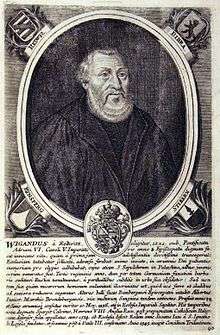Weigand of Redwitz
| Weigand of Redwitz | |
|---|---|
 Weigand of Redwitz, copper engraving by Johann Salver | |
| Noble family | Redwitz |
| Father | Henry of Redwitz at Theisenort and Tüschnitz |
| Mother | Agatha of Bibra |
| Born |
1476 Tüschnitz, now part of Küps |
| Died |
20 May 1556 Kronach |
| Buried | Bamberg Cathedral |



Weigand of Redwitz (1476 in Tüschnitz, now part of Küps – 20 May 1556 in Kronach) was Prince-Bishop of Bamberg from 1522 until his death.
Background
Weigand of Redwitz was a member of the Franconian Redwitz family. The Redwitzes were Imperial Knights; the family was named after Redwitz an der Rodach, a village in Lichtenfels district in Upper Franconia. Weigand was a son of Henry of Redwitz at Theisenort and Tüschnitz and his wife, Agatha of Bibra. His relative Catherine II of Redwitz (d. 1560) was Abbess of Obermünster Abbey in Regensburg from 1533 to 1536.
Life
Weigand of Redwitz became a canon in Bamberg in 1490. He made a pilgrimage to Jerusalem.
In 1520, he was the senior pastor of Kronach. Among his congregation was the reformer Johannes Grau, who had to flee to Wittenberg after he married the daughter of a citizen of Kronach. During his time as bishop, Weigand acted against Luther's followers and removed Lutheran clergy from office. However, under the restraining influence of his veteran advisor John of Schwarzenberg, he was less redical than some of the people who had elected him would have liked.
At the time Weigand was appointed bishop, Adrian VI was Pope and Charles V was Emperor. During his reign, the Peasants' War raged in the area. Over 70 manors and several monasteries were destroyed. Weigand attempted to resolve the conflict diplomatically. When military intervention appeared unavoidable, he turned to the Swabian League. The cathedral chapter also favoured intervention by the Swabian League. When the troubles began, the chapter had more rights than ever before, but now existential questions about their position were being posed. Although some of the canons may have sympathized with the Protestant faith, the demands of the peasant, which implied disempowering the canons, met with fierce resistance. The commander of the League's forces, Georg, Truchsess von Waldburg, was a loyal, but also ruthless military leader. Weigand's supporters were rewarded with properties confiscated from wealthy families in Bamberg. After the revolt was suppressed, Weigand, unlike some other feudal rulers, did not impose draconian punishments on the rebels. However, some rebel leaders were beheaded in the marketplace.
He pledged Veldenstein Castle to the Burgraviate of Nuremberg.[1]
During the Second Margrave War, near the end of his reign, the Protestant Margrave Albert III Alcibiades of Brandenburg-Kulmbach invaded his territory. Weigand was not prepared and had to give in to the Margrave's excessive demands. He ceded almost half of his territory. To secure his claims, Albert occupied the key central cities Forchheim and Bamberg. Albert Alcibiades had made many enemies with his bellicose behaviour and was defeated in 1553. He died in exile in 1557.
Coat of arms

Wiegand's coat of arms were quartered. The second and third field show the Redwitz family coat of arms. According to Siebmachers Wappenbuch, this consisted of a blue field with three silver bars, covered by a red diagonal bar. The other two quarters show the black lion of Bamberg, topped with a silver diagonal bar on golden ground.
Weigand's coat of arms can be found attached to the St. Veit Bastion of Forchheim Fortress. There are also several copies on the core castle of Rosenberg Fortress in Kronach, which was expanded by Weigand.
Grave monument in Michaelsberg Abbey
Weigand was buried in the Bamberg Cathedral. However, when this cathedral was restored, his grave monument was moved to the left aisle of the church of Michaelsberg Abbey, to achieve a greater stylistic unity in the Romanesque cathedral. The monument was designed by Hans Polster.[2]
References
- Friedrich Leitschuh (1897), "Wigand (Weigand) von Redwitz", Allgemeine Deutsche Biographie (ADB) (in German), 42, Leipzig: Duncker & Humblot, pp. 442–445
- Thomas Löwer: Der Schwäbische Bund im Hochstift Bamberg 1525 – Gründe für sein Einschreiten, study from the University of Marburg, 2002, ISBN 3-638-64212-7, (PDF).
- Werner Zeißner: Weigand von Redwitz (1476–1556), in: Alfred Wendehorst and Gerhard Pfeiffer (eds.): Fränkische Lebensbilder, in the series Veröffentlichungen der Gesellschaft für Fränkische Geschichte, series VII A, vol. 11, Kommissionsverlag Degener & Co, Neustadt/Aisch, 1984, ISBN 3-7686-9082-2, p. 44–60
External links
- Portrait of Weigand in the history of the abbey beer
- Description of his coat of arms
- More coats of arms
- Letter from Johannes Eck to Wiegand
- Letter from Wiegand to the Theological Department of the University of Ingolstadt
- Das Exemte Bistum Bamberg
- 1000 years diocese of Bamberg — portrait of the bishop
- Wiegand in the history of Pottenstein
- Wiegand in the history of Nordhalben
- Wiegand in the history of Bamberg
Footnotes
- ↑ weber-rudolf.de
- ↑ Konventsgebäude des ehem. Benediktinerklosters St. Michael at the archINFORM database. Retrieved 1 December 2009.
| Weigand of Redwitz Redwitz Born: 1476 Died: 20 May 1556 | ||
| Preceded by George III Schenk of Limpurg |
Bishop of Bamberg 1522-1556 |
Succeeded by George IV Fuchs of Rügheim |